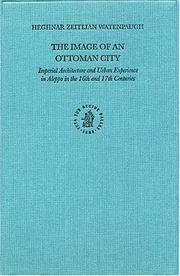| Listing 1 - 2 of 2 |
Sort by
|

ISBN: 9789004124547 9004124543 9786610859122 904740422X 1280859121 1433705478 9789047404224 9781433705472 9781280859120 6610859124 Year: 2004 Publisher: Leiden Boston Brill
Abstract | Keywords | Export | Availability | Bookmark
 Loading...
Loading...Choose an application
- Reference Manager
- EndNote
- RefWorks (Direct export to RefWorks)
This urban and architectural study of Aleppo, a center of early modern global trade, draws upon archival and narrative texts, architectural evidence, and contemporary theoretical discussions of the relation between imperial ideology, urban patterns and rituals, and architectural form. The first two centuries of Ottoman rule fostered tremendous urban development and reorientation through judiciously sited acts of patronage. Monumental structures endowed by Ottoman officials both introduced a new imperial architecture from Istanbul and incorporated formal elements from the local urban visual language. By viewing the urban and social contexts of these acts, tracing their evolution over two centuries, and examining their discussion in Ottoman and Arabic sources, this book proposes a new model for understanding the local reception and adaptation of imperial forms, institutions and norms.
Architecture, Ottoman - Syria - Aleppo. --- Architecture, Ottoman --- Islamic architecture --- Architecture and state --- Architecture --- Art, Architecture & Applied Arts --- History --- State and architecture --- Arab architecture --- Architecture, Arab --- Architecture, Islamic --- Architecture, Moorish --- Architecture, Muslim --- Architecture, Saracenic --- Moorish architecture --- Muslim architecture --- Saracenic architecture --- Religious architecture --- Ottoman architecture --- Aleppo (Syria) --- Aleppo --- Alep (Syria) --- Beroea (Syria) --- Chale (Syria) --- Chelbon (Syria) --- Haleb (Syria) --- Helbon (Syria) --- Halēp (Syria) --- Khalepion (Syria) --- Biblical Beroea (Syria) --- Berea (Syria) --- Madīnat Ḥalab (Syria) --- Ḥalab (Syria) --- Aram-Tsova (Syria) --- Ḥalev (Syria) --- Buildings, structures, etc.
Book
ISBN: 9789004169074 9004169075 9786612949319 9004193308 1282949314 9789004193307 Year: 2010 Volume: 41 Publisher: Leiden Boston Brill
Abstract | Keywords | Export | Availability | Bookmark
 Loading...
Loading...Choose an application
- Reference Manager
- EndNote
- RefWorks (Direct export to RefWorks)
As with most empires of the Early Modern period (1500-1800), the Ottomans mobilized human and material resources for warmaking on a scale that was vast and unprecedented. The present volume examines the direct and indirect effects of warmaking on Aleppo, an important Ottoman administrative center and Levantine trading city, as the empire engaged in multiple conflicts, including wars with Venice (1644-69), Poland (1672-76) and the Hapsburg Empire (1663-64, 1683-99). Focusing on urban institutions such as residential quarters, military garrisons, and guilds, and using intensively the records of local law courts, the study explores how the routinization of direct imperial taxes and the assimilation of soldiers to civilian life challenged – and reshaped – the city’s social and political order.
Aleppo (Syria) --- Solidarity --- Taxation --- Soldiers --- Guilds --- City and town life --- Political aspects --- History --- Economic aspects --- Turkey --- Politics and government --- Economic conditions --- Social conditions --- Duties --- Fee system (Taxation) --- Tax policy --- Tax reform --- Taxation, Incidence of --- Taxes --- Finance, Public --- Revenue --- City life --- Town life --- Urban life --- Sociology, Urban --- Craft guilds --- Gilds --- Labor organizations --- Merchant companies --- Workers' associations --- Artisans --- Employers' associations --- Labor unions --- Armed Forces personnel --- Members of the Armed Forces --- Military personnel --- Military service members --- Service members --- Servicemen, Military --- Armed Forces --- Cooperation --- Societies, etc. --- Ottoman Empire --- Aleppo --- Alep (Syria) --- Beroea (Syria) --- Chale (Syria) --- Chelbon (Syria) --- Haleb (Syria) --- Helbon (Syria) --- Halēp (Syria) --- Khalepion (Syria) --- Biblical Beroea (Syria) --- Berea (Syria) --- Madīnat Ḥalab (Syria) --- Ḥalab (Syria) --- Aram-Tsova (Syria) --- Ḥalev (Syria) --- Ottoman Empire, 1288-1918
| Listing 1 - 2 of 2 |
Sort by
|

 Search
Search Feedback
Feedback About UniCat
About UniCat  Help
Help News
News